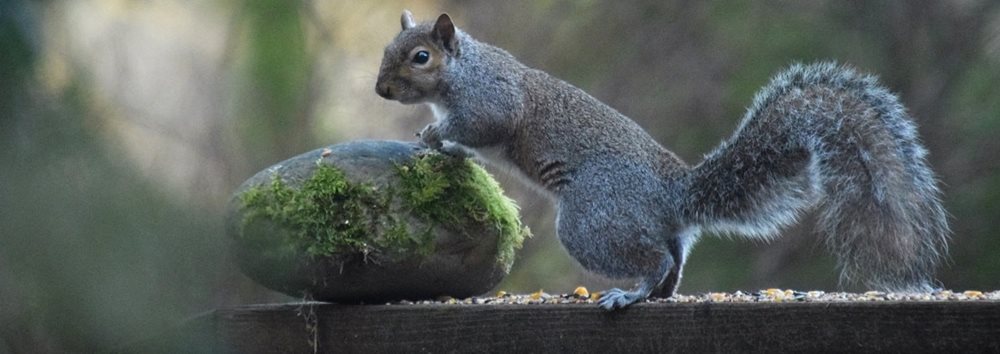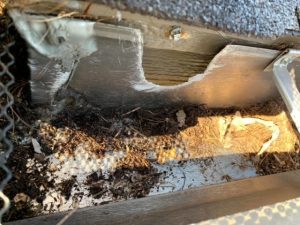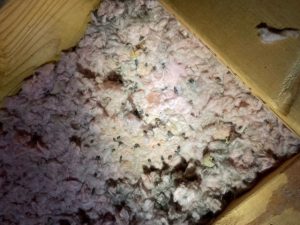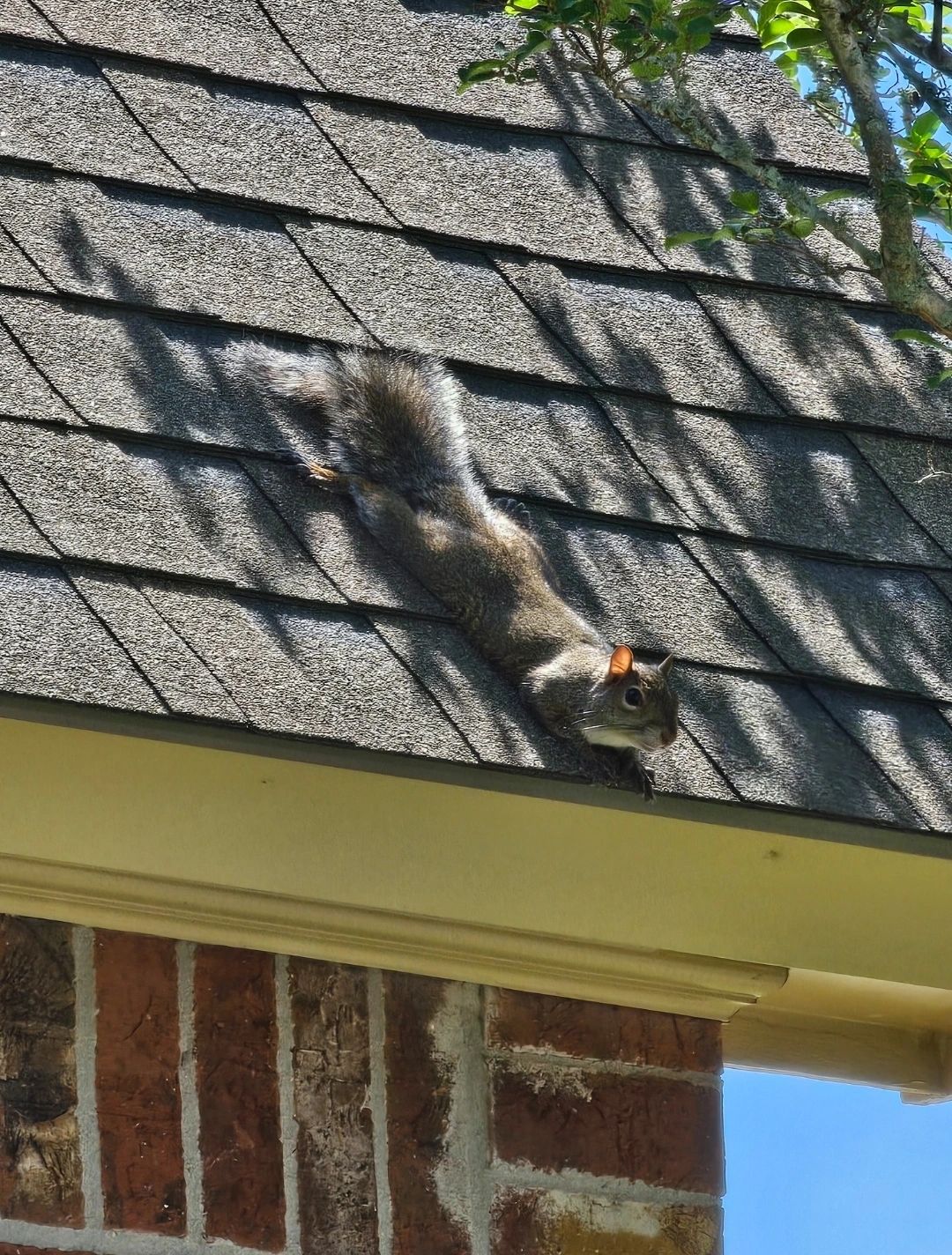
Safe, Fast, and Humane Squirrel Control for Homes and Businesses
Hearing noises in your attic? Seeing gnaw marks on your siding or roof? Smelling foul odors in your walls or ceiling?
When squirrels move in, they bring costly damage, safety hazards, and potential health risks. Critter Control provides fast, humane squirrel removal solutions to protect your home and your family.
Find a Critter Control near you
Signs You Have a Squirrel Problem
Squirrels leave noticeable clues behind. Look for:
- Scratching or scampering noises during daylight hours
- Chewed wires, wood, or siding
- Squirrel droppings in the attic or crawlspace
- Nests made of leaves and insulation
- Foul odors from dead squirrels or droppings
How to identify squirrel droppings
How to identify squirrel tracks
Why Do Squirrels Enter Homes?
Squirrels seek out homes for warmth and safety, especially during colder months.
- Shelter from weather and predators
- Safe nesting areas to raise young
- Easy access through trees, soffits, vents, and roof gaps
How squirrels get in through roofs and soffits
Why Are Squirrels Dangerous?
Squirrels create serious risks:
- Chewing on electrical wires → Fire hazard
- Contaminating insulation → Health risks
- Damaging wood, vents, and siding → Structural damage
- Blocking chimneys and vents → Carbon monoxide dangers
Where Squirrels Cause Problems
Squirrels can nest in many areas of your home:
- Attics→ Squirrels in attics
- Walls→ Squirrels in walls
- Chimneys→ Squirrels in chimneys
- Gutters→ Squirrels in gutters
- Roofs→ Squirrels on the roof
How We Remove Squirrels
Our proven process:
– Inspection & Identification
– Trapping & Removal
– Exclusion & Repairs
– Sanitation & Restoration
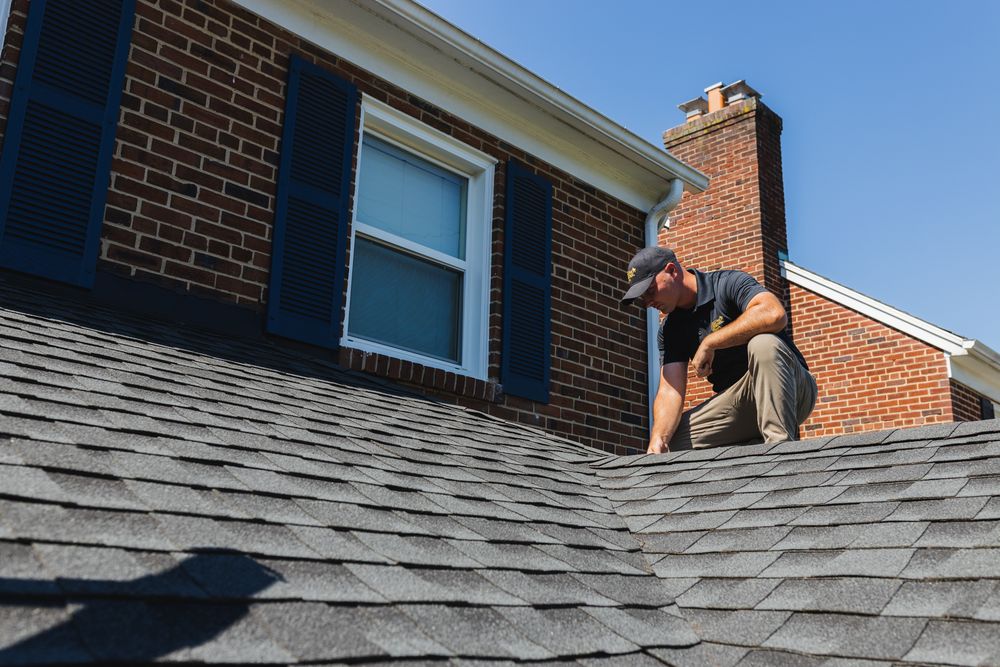
Why Choose Critter Control?
40+ Years of Squirrel Control Expertise
☑Licenses & Insured Wildlife Removal Professionals
☑Safe, Humane, & Environmentally Responsible Methods
☑100% Customer Satisfaction Guarantee
Squirrel Control Near You
Don’t let squirrels damage your home any longer.
Critter Control is ready to help — fast, safely, and humanely.
Call 1-800-274-8837 for Immediate Squirrel Removal Services.
Find Service in your Area:
Squirrel Control Near You
Don’t let squirrels damage your home any longer.
Critter Control is ready to help — fast, safely, and humanely.
Need Squirrel Removal Fast?
Get them out.
Keep them out.®
Experiencing a wildlife or pest issue? We can help! Complete this form and your local Critter Control® office will contact you to assist.
The best squirrel trap is to use a 5- x 5- x 18-inch (minimum) cage or box traps. Box traps are built with solid walls usually of wood, plastic, or sheet metal. Cage traps are made of wire mesh. For squirrels, use a cage trap from ½- x 1-inch mesh.
Both live traps can in either one door or two door traps. Snap traps or mouse traps glue traps will not work on most squirrels.
The best place to set these traps are near the entrances to your home or near evidence of squirrel activity. Signs of squirrels include dropping, runs or tracks in the insulation, gnaw marks, and squirrel nests. Do not rely on bait to overcome poor trap placement.
Squirrels are small, furry mammals in the rodent family known for their big, bushy tails.
The average adult squirrel may be anywhere from 12 to 25 inches (30 to 64 cm) long. As avid climbers, pest squirrels are typically muscular and have sharp claws. Their coloration varies greatly to include shades of black, gray, red, and brown. Squirrel fur is short, thick, and bushiest along the tail. The underbellies of most pest squirrels differ in color from the coats on their backs.
More information on what a squirrel looks like.
Though most squirrels orient themselves around the presence of trees, their chosen nesting sites vary from species to species. Fox squirrels, for example, prefer oak, pine, and mixed forests where the trees are widely spaced. Conversely, eastern gray squirrels live in forests where the trees allow for travel among the upper layer of leaves and branches, as they rarely move along the ground. Most species of squirrels build nests out of leaves and branches or use tree cavities as shelter.
A squirrel diet mostly comprised of nuts, seeds, flowers, herbaceous plants, and fungi, pest squirrels prefer to inhabit forested areas throughout the contiguous United States, Northeastern Mexico, and Southcentral Canada.
Squirrels are very common in residential areas and are often found in the yards and homes of humans. As overwintering pests, squirrels sometimes find their way into the attics of homes where they build nests and enjoy protection from cold weather. Yards with plenty of foliage are attractive to squirrels, who view trees as both a source of food and shelter.
Signs
Signs
As non-aggressive creatures, squirrels are capable of relatively peaceful cohabitation with humans. However, they also have the capacity for destruction. In yards, squirrels will dig up buried nuts and seeds, which leaves holes and disrupts the overall presentation, and chew the bark of ornamental trees and shrubbery. They also trample on and eat from gardens, feed on the contents of birdfeeders, and chew on birdhouses.
Inside homes, squirrels nest in attics and can chew and gnaw on wooden support beams and walls. They also endanger themselves and humans in the immediate area by chewing on electrical wires. Additionally, squirrels often travel on powerlines, which can lead to electrical shorts.
Proper exclusion is still vital after technicians remove problem squirrels. To keep new pests from taking their place, making some changes in the yard can help. Using metal collars or plastic pipes to prevent squirrels from climbing trees and buildings is one popular example. A professional wildlife control team can determine the most effective option.
Modifying homes and yards to make them less favorable to squirrels is the best form of squirrel control.
Follow these simple steps to prevent squirrels:
- Remove any food sources like birdseed, fallen fruits or vegetables, and pet food.
- Secure garbage cans
- Keep trees trimmed so that branches don’t hang over roofs and so squirrels cannot reasonably hide within the vegetation.
- Protect gardens with fences.
- Ensure any broken window screens and cracks leading into attics are repaired.
- Check chimneys as a possible point of entry, and seal them with mesh coverings.
What to do if you find a dead squirrel.
As squirrels are considered game in many states, trapping the pests may require the procurement of a special permit. Furthermore, though squirrels are not known to be particularly aggressive, it is always safer to contact a trained professional rather than attempt to handle wild animals without the proper knowledge or assistance. The wildlife specialists at Critter Control are skilled at identifying the different species of squirrels and handling squirrel removal properly and humanely. Our job is to protect people, property and wildlife and in doing so, we don’t exterminate squirrels, but instead we humanely exclude or remove them from your property
- How to Get Rid of Squirrels
- Squirrels Entering Homes
- Squirrels in Attics
- Squirrels in Chimneys
- Squirrels on Roofs & in Soffits
- Squirrels in Walls
- Squirrels in Ventilation
- Squirrels in Gutters
- Squirrels in Crawl Spaces
- Squirrels in Yards or Gardens
- Squirrels in Trees
- Squirrel Trapping
- Squirrel Repellents & Deterrents
- Dead Squirrel Removal
- Squirrel Damage to Your House
- Squirrel Appearance & Identification
- Species & Types of Squirrels
- How to Identify Squirrel Sounds
- Squirrel Tracks
- Squirrel Droppings
- Squirrel Nest
- Squirrel Life Cycle
- Baby Squirrels
- Squirrels Digging Holes in the Ground
- Squirrel Repellents & Deterrents
- Squirrel Diet
- Diseases That Squirrels Carry
- Rabid Squirrels
- Do Squirrels Hibernate?
- Gray Squirrels
- Do Squirrels Bite?
- Squirrels vs. Rats
- Squirrels vs. Chipmunks
